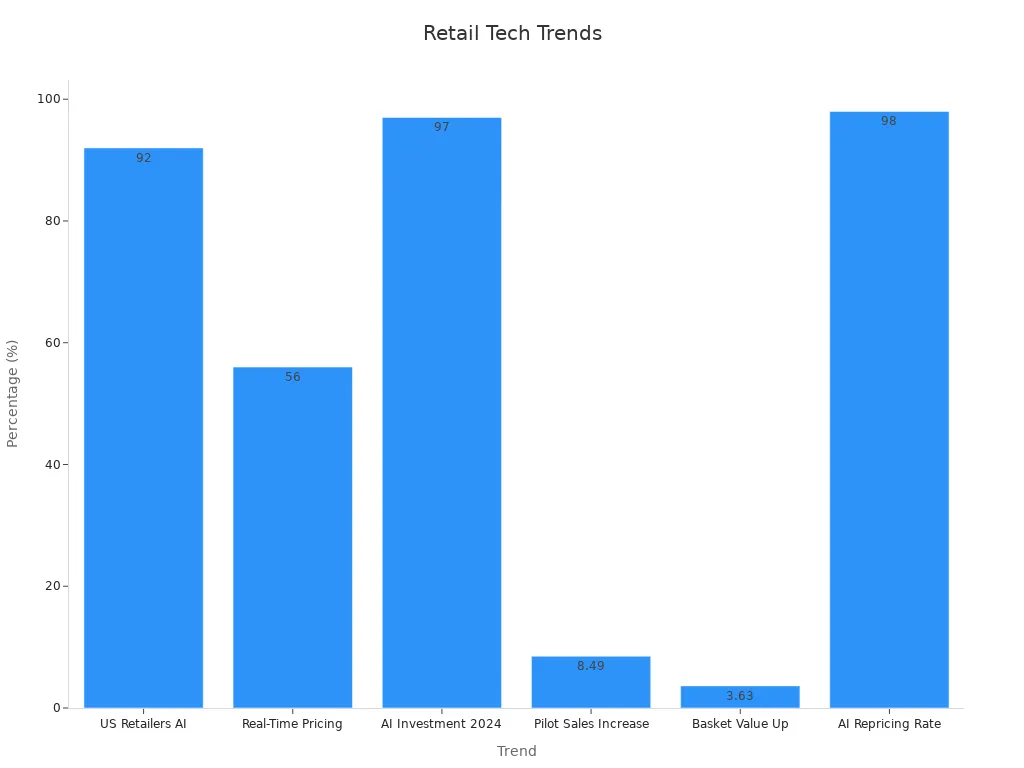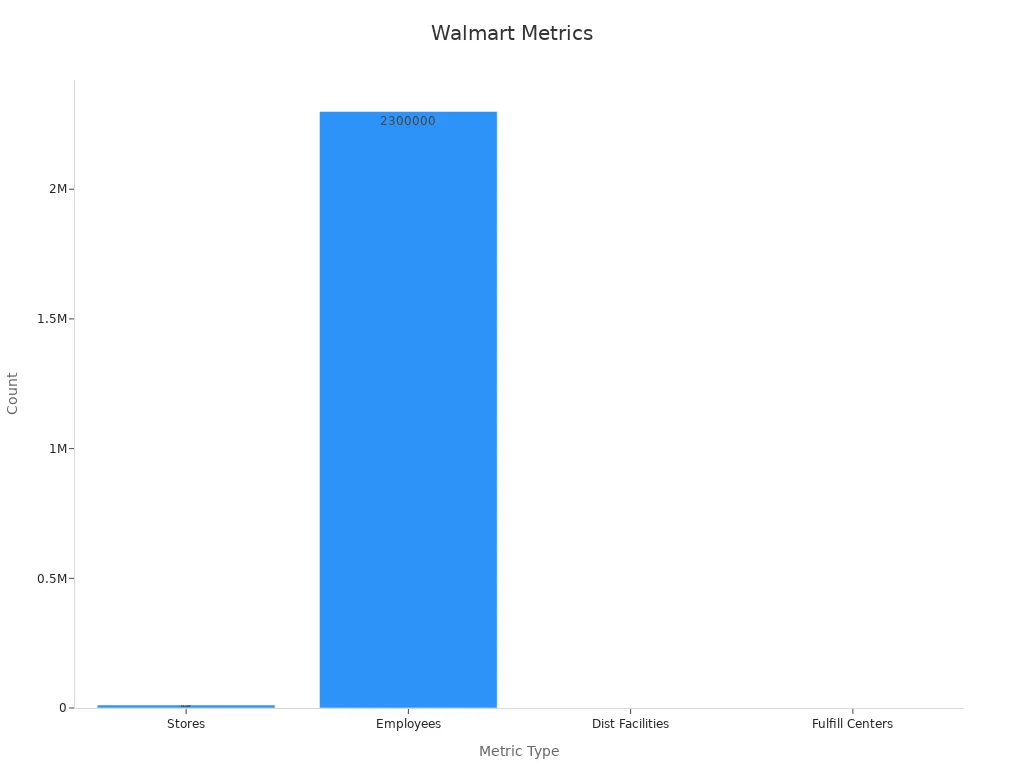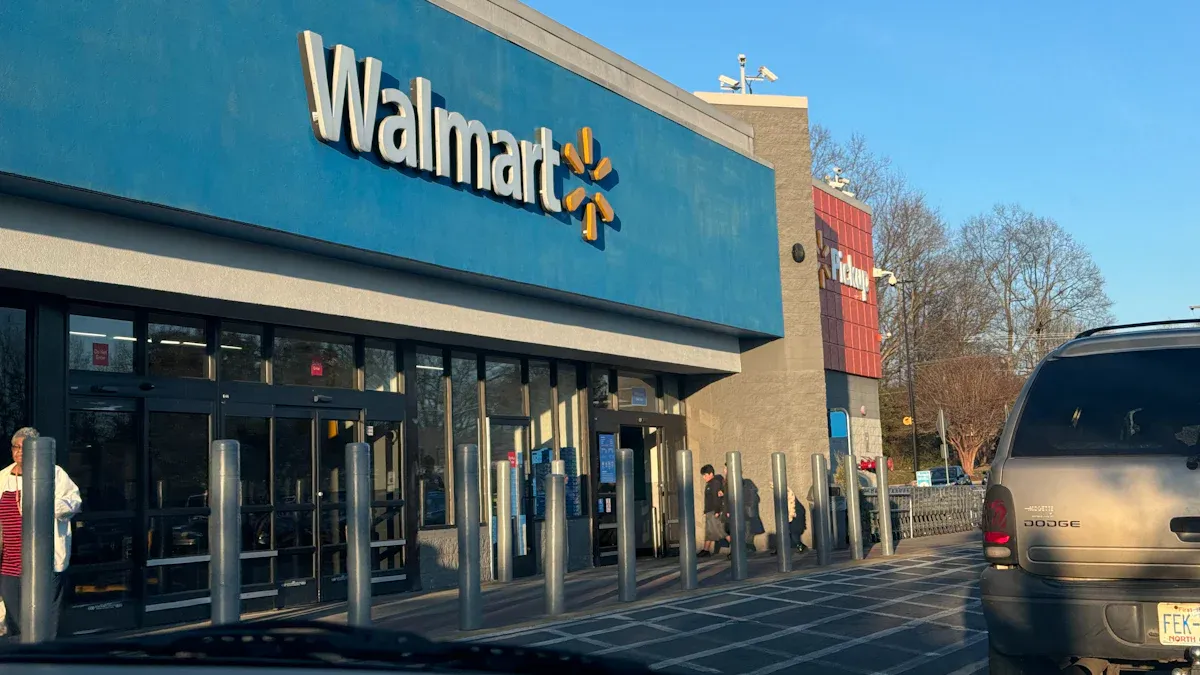
Walmart deploy digital shelf labels across the United States in 2025, replacing traditional tags with advanced Electronic Shelf Labels. Shoppers notice instantly updated prices and clearer product information. The retailer plans to automate 65% of its locations by 2026, including 2,300 stores with ESL Price Tag systems and ESL Gateway AP technology. With the adoption of Esl Retail solutions, Walmart leads the industry in real-time pricing and operational efficiency.

What Are Digital Shelf Labels at Walmart?

How Digital Shelf Labels Work in Walmart Stores
Electronic Shelf Labels Technology
Walmart uses electronic shelf labels to replace traditional paper tags on store shelves. This technology relies on small digital screens that display product prices and information. Each label connects wirelessly to a central system, allowing managers to update prices and details from a single dashboard. The system synchronizes with Walmart’s inventory and point-of-sale databases, ensuring that every price on the shelf matches the checkout price. These electronic shelf labels support features such as LED indicators for stock management and mobile app integration for rapid updates. By adopting this technology, Walmart streamlines operations and reduces the need for manual labor.
Real-Time Pricing Updates
Real-time pricing updates set digital shelf labels apart from traditional methods. When Walmart needs to change a price, the update happens instantly across thousands of products. This process eliminates delays and reduces the risk of mismatched prices between shelves and registers. Automated synchronization ensures pricing accuracy, which helps prevent customer complaints and builds trust. Academic research from European grocery chains shows that digital shelf labels enable more frequent price changes, supporting dynamic pricing strategies and reducing food waste. Walmart’s system allows for timely discounts on perishable goods, aligning with sustainability goals and improving operational efficiency.
Note: Expert commentary highlights that Walmart’s rollout of digital shelf labels is expected to enhance the shopper experience by improving pricing integrity, brand loyalty, and operational efficiency. Real-time updates and better inventory management lead to more accurate pricing and improved customer information.
Features of Walmart’s Digital Price Tags
Wireless Connectivity and Centralized Control
Walmart’s digital price tag system uses wireless connectivity to link every shelf label to a centralized control platform. Store managers can adjust prices, launch promotions, or update product details for thousands of items with just a few clicks. This centralized approach reduces the time required for price changes by up to 95%, as reported by retailers using similar systems. Automation nearly eliminates pricing errors, and staff can focus on customer service instead of manual updates. The integration with inventory and point-of-sale systems supports dynamic pricing and ensures that all information remains consistent throughout the store.
| Feature/Aspect | Walmart’s Digital Price Tags (ESL) | Traditional Price Tags |
|---|---|---|
| Update Speed | Instant, automated updates across thousands of products | Slow, manual updates taking hours or days |
| Pricing Accuracy | Highly accurate due to automation and real-time synchronization | Prone to human errors and mismatched prices |
| Integration | Connected to inventory and POS systems for dynamic pricing | No integration; manual price changes only |
| Dynamic Pricing | Supports real-time price changes based on demand or promotions | Not feasible; manual and static pricing |
| Customer Engagement | Interactive features like QR codes for promotions and info | Static, no interactive capabilities |
| Labor Costs | Significantly reduced due to automation | High due to manual labor |
| Environmental Impact | Minimal waste, reduces paper and ink use | Generates significant paper and ink waste |
| Operational Efficiency | Streamlined operations, fewer errors, faster price changes | Slower, error-prone, labor-intensive |
Durability and Display Quality
Walmart’s digital shelf labels feature robust construction designed for the demands of high-traffic retail environments. The displays use energy-efficient screens that remain clear and readable under various lighting conditions. These labels resist dust, moisture, and accidental impacts, ensuring long-term reliability. The high-resolution screens present prices, product names, and promotional information in a format that is easy for shoppers to read. Interactive elements, such as QR codes, provide instant access to additional product details and special offers. This combination of durability and display quality supports Walmart’s commitment to operational excellence and customer satisfaction.
Tip: Digital shelf labels not only reduce operational waste but also support Walmart’s sustainability goals by minimizing the use of paper and ink. The transition to digital solutions aligns with broader trends in retail innovation and environmental responsibility.
Why Walmart Deploy Digital Price Tags Now?
Operational Efficiency and Labor Savings
Faster Price Changes Across Stores
Walmart deploys digital price tags to achieve rapid price changes across its vast network of stores. The company’s disciplined approach to technology investments focuses on return on investment, with quarterly executive reviews ensuring that each project delivers measurable savings. Digital shelf labels allow Walmart to update prices in real time, reducing the time required for price changes from two weeks to just five minutes. This automation eliminates the need for manual updates, which previously consumed significant labor hours and introduced the risk of errors.
A comparison of operational metrics highlights the impact:
| Operational Metric | Impact / Improvement |
|---|---|
| Labor cost reduction | Up to 90% reduction in labor costs |
| Manual price update time | Reduced from two weeks to five minutes |
| Pricing errors | Eliminated through automation |
| Dynamic pricing capabilities | Real-time adjustments based on market and inventory data |
| Paper label printing costs | Eliminated, contributing to cost savings |
Electronic Shelf Label systems achieve price update speeds that are 8 to 10 times faster than traditional methods. This acceleration enables Walmart to respond quickly to market changes and competitor pricing, maintaining its reputation as a cost-effective retailer. Staff can now focus on higher-value tasks, such as customer service and omni-channel order picking, rather than spending hours on manual price changes.
Reducing Manual Errors and Labor Costs
Automation through digital price tags significantly reduces manual errors. In the past, employees manually replaced thousands of paper tags, which often led to mismatches between shelf and checkout prices. Digital shelf labels synchronize with Walmart’s central pricing system, ensuring consistency and accuracy throughout the store. This technology eliminates pricing errors and reduces the risk of consumer complaints related to incorrect prices.
Labor savings represent another major benefit. By automating price changes, Walmart reduces labor costs by up to 90%. Employees who previously handled manual updates can now be reallocated to roles that enhance the consumer experience. The elimination of paper label printing also contributes to cost savings and supports Walmart’s sustainability goals.
Note: Walmart’s history of early digital adoption, such as its leadership in Buy Online, Pick up in Store (BOPIS) and mobile app innovations, demonstrates a consistent focus on operational efficiency and customer experience. These strategic moves validate the timing of Walmart’s deployment of digital price tags compared to industry benchmarks.
Enhancing Customer Experience with Digital Shelf Labels
Accurate Pricing at Checkout
Consumers expect pricing accuracy at checkout. Digital shelf labels ensure that the price displayed on the shelf always matches the price at the register. This real-time synchronization eliminates confusion and builds trust with shoppers. Automated updates also support dynamic pricing strategies, allowing Walmart to offer timely discounts and respond to market trends without delay.
Walmart’s advanced algorithms monitor competitor prices and adjust its own pricing automatically. This capability helps Walmart maintain its position as a price leader, ensuring that consumers perceive the retailer as offering the best value. Accurate pricing at checkout reduces disputes and enhances the overall shopping experience.
More Product Information for Shoppers
Digital price tags provide consumers with more than just prices. The high-resolution displays can show product names, promotional details, and even QR codes that link to additional information. Shoppers can access real-time deals and offers directly from the shelf, making it easier to find the best value.
Walmart’s integration of digital shelf labels with its inventory and point-of-sale systems allows for instant updates and improved product visibility. Consumers benefit from clear, up-to-date information, which supports informed purchasing decisions. This enhanced transparency aligns with Walmart’s commitment to customer satisfaction and operational excellence.
Pricing Benefits for Shoppers at Walmart
Easier and Faster Price Checks
Instantly Updated Prices on Shelves
Walmart’s digital shelf labels transform the way shoppers check prices in stores. The system connects each label electronically to the point-of-service network, allowing for real-time price updates. When Walmart adjusts prices, the changes appear instantly on the shelves. This process eliminates the delays that often occurred with manual updates. Shoppers now see the most current prices every time they visit, which increases confidence in the accuracy of grocery store prices.
The automation behind these digital tags removes the need for employees to spend hours replacing paper labels. Instead, staff can update thousands of prices within minutes. This rapid update capability not only improves pricing accuracy but also allows Walmart to respond quickly to market changes. Shoppers benefit from reliable and up-to-date price information, making their experience more efficient.
Clearer Product Details and Promotions
Digital shelf labels do more than display prices. The high-resolution screens present clear product names, promotional offers, and even QR codes for additional information. Shoppers can easily spot special deals or limited-time discounts as they browse the aisles. The clarity of these displays reduces confusion and helps customers make informed decisions. By providing more detailed information at the shelf, Walmart enhances transparency and supports smarter shopping.
Tip: Shoppers can scan QR codes on digital price tags to access product details, nutritional facts, or current promotions, making it easier to compare options and find the best value.
Access to Real-Time Deals and Offers
Flash Sales and Immediate Discounts
Walmart’s digital shelf labels enable the company to launch flash sales and immediate discounts with unprecedented speed. Managers can activate dynamic promotions across the store in seconds. Shoppers benefit from these real-time deals, which appear instantly on the shelf displays. This capability allows Walmart to adjust pricing based on inventory levels, demand, or special events, ensuring that customers always have access to competitive prices.
Dynamic pricing strategies help Walmart offer timely discounts on perishable goods or overstocked items. The flexibility of the system means that shoppers can take advantage of lower prices as soon as they become available, without waiting for traditional sales cycles.
Future Potential for Personalized Pricing
The technology behind digital shelf labels opens the door to future innovations in personalized pricing. As Walmart continues to integrate its digital ecosystem, shoppers may one day receive tailored offers based on their preferences or shopping history. While the company has stated it will not use the system for unfair price increases, dynamic pricing can still provide value by matching deals to individual needs.
Dynamic pricing also supports Walmart’s ability to compete with online retailers, offering shoppers the best possible prices in real time. As the technology evolves, customers can expect even more customized and responsive pricing experiences in-store.
Walmart Deploy Digital Shelf Labels for Business Advantages
Streamlined Pricing Operations
Centralized Price Management System
Walmart deploy digital shelf labels to centralize price management across thousands of stores. The company uses a single IT infrastructure to standardize price changes and promotions. This system enables managers to update prices for over 120,000 products instantly, eliminating manual errors and reducing labor time. Employees can now focus on customer service instead of repetitive tasks. The centralized approach supports Walmart’s price strategy of Everyday Low Prices, ensuring consistency and control throughout the retail network.
| Aspect | Evidence |
|---|---|
| Customer Reach | Serves over 240 million customers weekly in 26 countries. |
| Centralized Information System | Standardizes pricing and promotions, reducing costs. |
| Operational Efficiency | Allows rapid price adjustments and efficient inventory management. |
| Big Data and Analytics | Optimizes pricing strategies and enhances customer experience. |
Rapid Rollout of Promotions and Sales
Walmart’s digital shelf labels allow for the rapid rollout of promotions and sales. Managers can launch storewide discounts or targeted offers in minutes. This agility supports dynamic price changes and helps Walmart respond quickly to market trends and competition. Real-time accuracy of shelf prices ensures that customers always see the latest deals, improving the shopping experience and supporting operational efficiency.
Note: By eliminating manual price changes, Walmart reduces labor time and errors, while dynamic management of price changes across thousands of products enhances both efficiency and customer satisfaction.
Data, Analytics, and Inventory Management
Real-Time Sales Tracking
Digital shelf labels provide real-time sales tracking by displaying up-to-the-minute product information. Walmart reduced the time to update shelf prices from two days to about two minutes, demonstrating significant labor savings. The system enables dynamic pricing and improved sales tracking, reducing human error and customer complaints. Employees can monitor product supplies more efficiently, supporting better in-store inventory management.
- Real-time display of prices, discounts, and inventory levels.
- Fewer pricing errors and lost sales.
- On-shelf lights highlight SKUs needing updates, speeding up restocking and fulfillment.
Improved Inventory Control
Walmart’s digital shelf labels improve inventory control by enabling markdowns that reduce overstock and minimize food waste. When combined with inventory tracking, these labels nearly eliminate food waste, enhancing supply chain efficiency. The technology reduces reliance on last-minute supply purchases and inefficient warehousing, supporting better inventory accuracy and restocking. Retailers use these systems to maintain customer loyalty through effective price strategy rather than surge pricing.
A study by Auburn University’s RFID Lab found that retailers using similar technology achieved up to 25% improvement in inventory accuracy and a 10-15% increase in sales due to better product availability. Walmart’s collaboration with VusionGroup aims to turn physical stores into digital assets, maximizing efficiency and improving store performance through AI-powered insights.
Gaining a Competitive Edge in Retail
Leading Industry Innovation
Walmart deploy digital shelf labels to lead innovation in the retail sector. The company’s integration of digital price tags with point-of-sale systems ensures flawless synchronization between shelf and checkout prices. Automation saves labor hours, allowing staff to focus on higher-value tasks. Agile pricing capabilities support markdowns on perishables and targeted promotions, giving Walmart an edge in competition.
Setting New Retail Standards
Walmart’s rapid deployment of digital shelf labels sets new standards for retail operations. The technology supports personalized marketing, cross-selling, and real-time offers, enhancing customer engagement. Automated alerts and streamlined workflows improve product availability and replenishment efficiency. These advancements position Walmart as a leader in retail, driving operational excellence and shaping the future of in-store inventory management.

Challenges and Concerns with Digital Price Tags at Walmart
Technology Limitations and Maintenance
Reliability and Upkeep of Digital Shelf Labels
Walmart’s digital shelf labels introduce new reliability and maintenance challenges. Hardware failures, such as display malfunctions or battery depletion, disrupt the shopping experience and create confusion for the consumer. Connectivity problems, including dead zones, can cause missed price updates. These issues undermine the accuracy of shelf information and erode consumer trust. System downtime and inconsistent updates add uncertainty about pricing and product details. Ongoing maintenance requires technical support and battery management, which increases labor demands and operational costs. Staff must adapt to these new responsibilities, and some employees resist the shift to automated systems.
Power and Connectivity Issues
Power and connectivity remain critical for the success of digital shelf labels. In high-traffic retail environments, maintaining a stable connection across thousands of devices presents a significant challenge. Integration with legacy systems often leads to operational disruptions and data inconsistencies. Skilled personnel must manage and maintain these systems, but training requirements and resistance to change slow adoption. Ensuring continuous service during updates and maintaining compatibility across multiple retail points require careful planning. Data security risks also emerge, demanding robust cybersecurity measures to protect sensitive information.
Consumer Concerns About Pricing
Dynamic Pricing Fears and Walmart’s Policy
The introduction of dynamic pricing raises concerns among the consumer base. Many shoppers worry that prices could change too frequently or unfairly, especially during peak shopping periods. Walmart has stated that it will not use dynamic pricing to increase prices unfairly, but the potential for rapid price adjustments still causes unease. Consumers expect transparency and consistency, and any perception of unpredictable pricing can damage trust. Clear communication about pricing policies and the purpose of dynamic price changes remains essential for maintaining consumer confidence.
Privacy and Data Use Questions
Consumers also question how Walmart uses data collected through digital shelf labels and related systems. The integration of dynamic pricing and in-store inventory management relies on large volumes of customer and product data. Shoppers want assurance that their information remains secure and that Walmart uses it responsibly. Data security risks from automation systems require strong cybersecurity frameworks. Walmart must address these concerns to maintain a positive relationship with its customers.
Impact on Walmart Employees
Changes in Store Roles and Responsibilities
The deployment of digital shelf labels shifts employee roles and responsibilities. Many workers report increased workloads and task shifting as they support both traditional and e-commerce operations. Employees often move from their regular duties to assist with new technology, causing delays and longer checkout lines. This redistribution of tasks leads to frustration and tension among staff, who sometimes perform double duty to keep up with demands. Union representatives confirm that staffing demands surge during peak times, pulling workers from various departments and creating operational challenges.
Training for New Technology
Training becomes essential as Walmart introduces digital shelf labels and dynamic pricing systems. Employees must learn to manage and maintain new devices, adapt to changing workflows, and address technical issues. Some workers express concern that the pace of technology deployment outpaces their ability to adapt. Adequate training and support help reduce resistance and ensure a smooth transition. Ongoing education and clear communication remain vital for employee morale and operational success.
How Walmart’s Digital Shelf Labels Compare to Other Retailers
Digital Price Tag Adoption in the Retail Industry
Examples from Target, Kroger, and Others
Major U.S. retailers have embraced digital price tags to improve pricing accuracy and shopper engagement. Kroger has replaced traditional paper tags with smart shelves in 500 stores. These shelves use AI, sensors, and data science to analyze shopper behavior and deliver targeted marketing. Kroger’s Enhanced Display for Grocery Environment (EDGE) Shelf technology enables dynamic pricing and personalized offers. The system uses cameras and facial recognition, in partnership with Microsoft, to tailor marketing and optimize pricing strategies. This approach has drawn attention from lawmakers concerned about privacy and price surges, but Kroger maintains that the technology helps lower prices where it matters most.
Target has also invested in digital price-related tools. The retailer achieved over 10 million new transactions in Q3 2024 by reducing prices on more than 10,000 items. Target plans to cut prices on 2,000 more items during the holidays. Digital coupons play a key role in driving digital sales, with 82% of grocers identifying them as essential. Shoppers have increased their use of digital coupons by 59%, and integration with loyalty programs like Target Circle has boosted basket sizes and order frequency.
| Statistic / Example | Value / Description |
|---|---|
| Kroger smart shelves | 500 stores nationwide |
| Target digital sales growth | 10M+ new transactions in Q3 2024 via price cuts |
| Grocers using digital coupons | 82% |
| Shoppers increasing digital coupon use | 59% |
| Promotions extended year-round | 59% of grocers |
Global Trends in Digital Shelf Labels
Digital shelf label adoption continues to grow worldwide. Europe led the market in 2023, with a 38% share and major retailers like Carrefour, Metro AG, and Tesco using electronic shelf labels. The Asia-Pacific region, especially China, Japan, and South Korea, has seen rapid expansion. Companies such as M2COMM and SoluM have advanced ESL systems and expanded into new markets. The global market for electronic shelf labels is projected to grow from $1.4 billion in 2024 to $7.53 billion by 2034, with a compound annual growth rate of 18.3%. Retail automation, IoT adoption, and dynamic pricing drive this growth.
| Aspect | Details |
|---|---|
| Europe ESL Market | 38% share in 2023; Carrefour, Metro AG, Tesco |
| APAC Growth | Rapid expansion in China, Japan, South Korea |
| Global ESL Market Size | $1.4B (2024) to $7.53B (2034) |
| CAGR | 18.3% (2024-2034) |
| Leading Technologies | LCD ESLs, ZigBee wireless |
| Key Competitors | SES-imagotag, Pricer AB, SoluM |
What Makes Walmart Deploy Unique
Scale and Speed of Implementation
Walmart deploy digital shelf labels at a scale unmatched by most competitors. The company announced its rollout in June 2024, targeting 2,300 locations over two years after a successful Texas trial. This rapid deployment aligns with global trends in real-time pricing and operational efficiency. Walmart’s approach stands out for its speed and the number of stores involved, setting a new benchmark for the industry.
Integration with Walmart’s Digital Ecosystem
Walmart integrates digital shelf labels with its broader digital ecosystem. The system connects with inventory management, point-of-sale, and analytics platforms. This integration allows Walmart to synchronize pricing, promotions, and inventory in real time. The company leverages partnerships with technology providers like Vusion Group to ensure reliable performance and future scalability. By combining digital shelf labels with advanced analytics and automation, Walmart strengthens its position as a leader in retail technology.
Note: Walmart’s large-scale deployment and seamless integration with its digital infrastructure distinguish it from other retailers, supporting both operational excellence and enhanced customer experience.
What Shoppers Can Expect from Walmart Deploy in 2025

In-Store Experience with Digital Shelf Labels
Navigating New Price Tags and Displays
Shoppers entering Walmart stores in 2025 will notice digital shelf labels replacing traditional paper tags. These electronic displays present prices, product names, and promotional details in a clear, easy-to-read format. Customers can quickly scan shelves for the latest deals or use QR codes to access additional product information. The digital labels update instantly, ensuring that the price on the shelf always matches the price at checkout. This real-time accuracy reduces confusion and builds trust among shoppers.
Industry experts highlight that Walmart’s digital shelf labels aim to improve operational efficiency rather than eliminate jobs. The technology allows staff to spend less time on manual price changes and more time assisting customers. While some shoppers express concerns about potential surge pricing or privacy issues, academic studies show that digital shelf labels rarely result in sudden price hikes. In fact, temporary discounts have become more common, and price manipulation remains extremely rare.
Tip: Shoppers can look for special icons or QR codes on digital shelf labels to discover exclusive promotions or learn more about product features.
Interacting with Store Associates
Store associates will play a key role in helping customers adapt to the new digital shelf label system. Employees receive training to answer questions about the technology and guide shoppers in using interactive features. Associates can demonstrate how to scan QR codes or locate real-time deals displayed on the shelves. With less time spent on manual updates, staff can focus on providing personalized service and ensuring a smooth shopping experience.
Walmart’s approach emphasizes customer support and transparency. Associates remain available to address any concerns about pricing or privacy, reinforcing the company’s commitment to shopper satisfaction. As digital shelf labels become more familiar, customers can expect faster assistance and more knowledgeable staff throughout the store.
Future Possibilities for Pricing and Shopping
Integration with Walmart Mobile Apps
Walmart continues to invest in digital innovation, enhancing the connection between in-store experiences and mobile technology. The company’s mobile app integrates with digital shelf labels, allowing shoppers to:
- Scan QR codes for instant access to product reviews and nutritional information.
- Receive personalized recommendations based on shopping history.
- Track real-time promotions and flash sales as they browse the aisles.
Walmart’s launch of generative AI-powered search and shopping assistants in 2024 has improved the mobile experience. Features such as AI-generated product reviews and customer support assistants help shoppers make informed decisions quickly. The integration of digital shelf labels with mobile apps creates a seamless, interactive environment for both in-store and online customers.
Personalized Shopping Experiences
Personalization stands at the forefront of Walmart’s retail strategy. The company uses generative AI and predictive analytics to enhance product recommendations and tailor promotions to individual shoppers. Large language models analyze customer intent and shopping patterns, delivering hyper-specific offers and real-time suggestions.
- Walmart enhances over 850 million pieces of product data with AI, improving descriptions and recommendations.
- Predictive analytics optimize inventory, reducing waste and ensuring popular items remain in stock.
- Investments in AR and immersive commerce platforms allow customers to visualize products in 3D, making shopping more engaging.
Industry forecasts suggest that AI will unlock $136 billion in value for grocery retail by 2030, with personalization driving higher conversion rates and customer satisfaction. Walmart’s leadership in adaptive retail positions it to deliver unique, tailored experiences that meet the evolving needs of shoppers. As digital shelf labels and AI-powered tools continue to advance, customers can expect even more relevant deals, targeted promotions, and interactive shopping journeys in the years ahead.
Walmart’s digital shelf labels signal a major transformation in retail. Shoppers will see more accurate prices on every shelf, with updates happening faster than ever. The system allows managers to adjust prices instantly, which helps maintain consistency throughout the store. While some challenges remain, Walmart’s investment in this technology sets a new standard for retail innovation. Both customers and the company benefit from improved prices and a better shopping experience.
FAQ
What are digital shelf labels at Walmart?
Digital shelf labels are small electronic displays that show product prices and information. Walmart uses these labels to update prices instantly and provide accurate details on store shelves.
How do digital price tags improve shopping at Walmart?
Digital price tags ensure that shelf prices always match checkout prices. Shoppers see real-time updates, clear promotions, and can access more product information using QR codes.
Will Walmart use digital shelf labels for surge pricing?
Walmart states that it will not use digital shelf labels to increase prices unfairly. The company focuses on transparency and consistency to maintain customer trust.
Do digital shelf labels require special maintenance?
Store staff monitor digital shelf labels for battery life and connectivity. Regular checks help prevent display issues and ensure accurate pricing information for shoppers.
Can shoppers interact with digital shelf labels?
Shoppers can scan QR codes on digital shelf labels to view product details, reviews, or current promotions. This feature helps customers make informed decisions quickly.
How do digital shelf labels affect Walmart employees?
Employees spend less time on manual price changes. They receive training to manage the new technology and focus more on customer service and store operations.
Are digital shelf labels secure and private?
Walmart uses secure systems to protect pricing and inventory data. The company follows strict privacy policies to safeguard customer information and prevent unauthorized access.
Will other retailers follow Walmart’s lead with digital price tags?
Many retailers already use digital shelf labels in select stores. Walmart’s large-scale deployment may encourage more companies to adopt similar technology for efficiency and accuracy.


